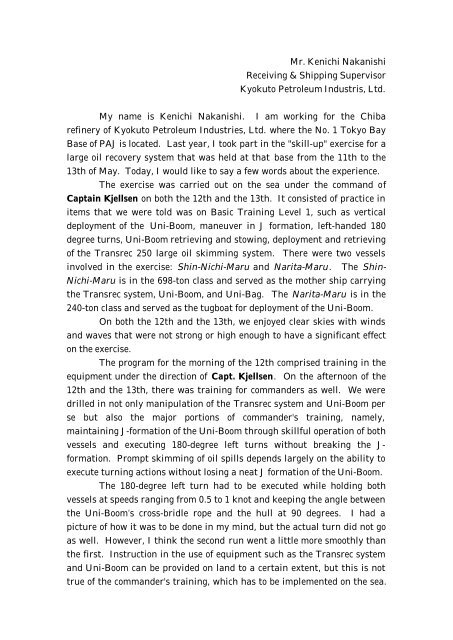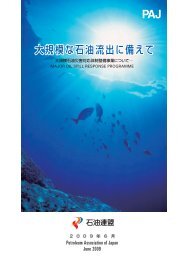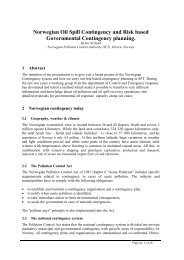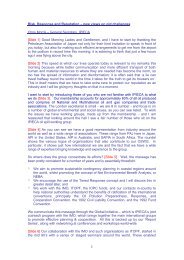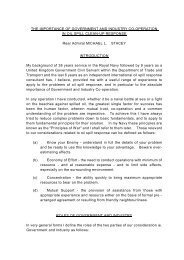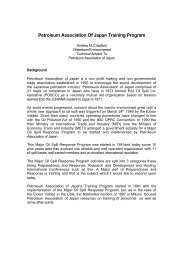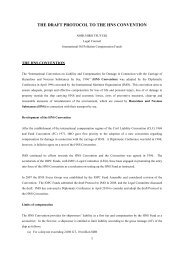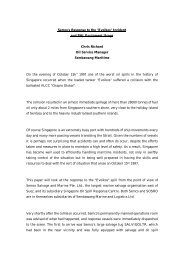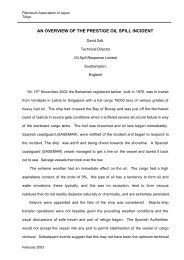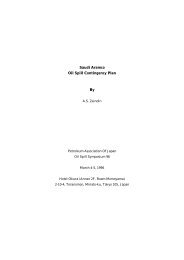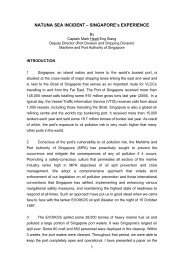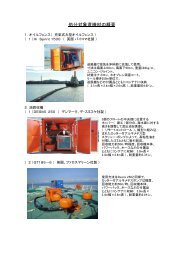Mr. Kenichi Nakanishi Receiving & Shipping Supervisor Kyokuto ...
Mr. Kenichi Nakanishi Receiving & Shipping Supervisor Kyokuto ...
Mr. Kenichi Nakanishi Receiving & Shipping Supervisor Kyokuto ...
Create successful ePaper yourself
Turn your PDF publications into a flip-book with our unique Google optimized e-Paper software.
<strong>Mr</strong>. <strong>Kenichi</strong> <strong>Nakanishi</strong><br />
<strong>Receiving</strong> & <strong>Shipping</strong> <strong>Supervisor</strong><br />
<strong>Kyokuto</strong> Petroleum Industris, Ltd.<br />
My name is <strong>Kenichi</strong> <strong>Nakanishi</strong>. I am working for the Chiba<br />
refinery of <strong>Kyokuto</strong> Petroleum Industries, Ltd. where the No. 1 Tokyo Bay<br />
Base of PAJ is located. Last year, I took part in the "skill-up" exercise for a<br />
large oil recovery system that was held at that base from the 11th to the<br />
13th of May. Today, I would like to say a few words about the experience.<br />
The exercise was carried out on the sea under the command of<br />
Captain Kjellsen on both the 12th and the 13th. It consisted of practice in<br />
items that we were told was on Basic Training Level 1, such as vertical<br />
deployment of the Uni-Boom, maneuver in J formation, left-handed 180<br />
degree turns, Uni-Boom retrieving and stowing, deployment and retrieving<br />
of the Transrec 250 large oil skimming system. There were two vessels<br />
involved in the exercise: Shin-Nichi-Maru and Narita-Maru. The Shin-<br />
Nichi-Maru is in the 698-ton class and served as the mother ship carrying<br />
the Transrec system, Uni-Boom, and Uni-Bag. The Narita-Maru is in the<br />
240-ton class and served as the tugboat for deployment of the Uni-Boom.<br />
On both the 12th and the 13th, we enjoyed clear skies with winds<br />
and waves that were not strong or high enough to have a significant effect<br />
on the exercise.<br />
The program for the morning of the 12th comprised training in the<br />
equipment under the direction of Capt. Kjellsen. On the afternoon of the<br />
12th and the 13th, there was training for commanders as well. We were<br />
drilled in not only manipulation of the Transrec system and Uni-Boom per<br />
se but also the major portions of commander's training, namely,<br />
maintaining J-formation of the Uni-Boom through skillful operation of both<br />
vessels and executing 180-degree left turns without breaking the J-<br />
formation. Prompt skimming of oil spills depends largely on the ability to<br />
execute turning actions without losing a neat J formation of the Uni-Boom.<br />
The 180-degree left turn had to be executed while holding both<br />
vessels at speeds ranging from 0.5 to 1 knot and keeping the angle between<br />
the Uni-Boom’s cross-bridle rope and the hull at 90 degrees. I had a<br />
picture of how it was to be done in my mind, but the actual turn did not go<br />
as well. However, I think the second run went a little more smoothly than<br />
the first. Instruction in the use of equipment such as the Transrec system<br />
and Uni-Boom can be provided on land to a certain extent, but this is not<br />
true of the commander's training, which has to be implemented on the sea.
It was indeed a precious experience.<br />
I must add that, perhaps carried away with enthusiasm, we sailed<br />
out of the bounds of the prescribed exercise zone on the 13th. Getting back<br />
in bounds gave us the chance to experience a right-handed 180-degree turn,<br />
which was not in the original program. I understand that this type of turn<br />
corresponds with Level 2 of Basic Training. Although this was a notch<br />
above the 180-degree left turn, we were allowed to take up the challenge<br />
being advised by Capt. Kjellsen. With the help of the outstanding<br />
navigational expertise of the veteran skippers of both the Shin-Nichi-Maru<br />
and Naritamaru, we made the right turn. I am grateful to both of them for<br />
giving us this wonderful extra experience.<br />
We also encountered some trouble during the exercise. The chief<br />
incidents on the 12th were entanglement of the cross-bridle net in the gap<br />
between the reel drum and Uni-Boom during extension, the snagging of the<br />
net on protuberances on the side of the ship, and the cutting of the cross-<br />
bridle rope, probably due to excessive tension when taking in the Uni-Boom.<br />
The chief one on the 13th was the difficulty encountered when we began<br />
deploying the Transrec’s skimmer and tried to operate by remote control.<br />
The remote control system stopped functioning because the cord was pulled<br />
strongly and the connection became poor, perhaps due to the improper<br />
position of the cord on the deck, and we immediately switched to operation<br />
on the Transrec system side panel.<br />
Transceivers were used for communication between the training<br />
leader and the operators of the Uni-Boom and Transrec system. There<br />
were no earphones or headphones, and the loud sound of the power pack<br />
impeded direct contact with the operators. This drove home to us the need<br />
for relay personnel with transceivers.<br />
Naturally, the point is to acquire skills through repeated exercise.<br />
The occurrence of trouble and incidents during the exercise motivates<br />
reviews and repeated practice, with a commensurate improvement in skills.<br />
As such, I think they will serve us in good stead in the actual event.<br />
In sum, we encountered some minor difficulties, but I recall that<br />
Capt. Kjellsen and the system supervisors rated the exercise a success as a<br />
first effort.<br />
Exercise of this type is absolutely necessary, and I hope that more of<br />
us can experience it over the coming years.


